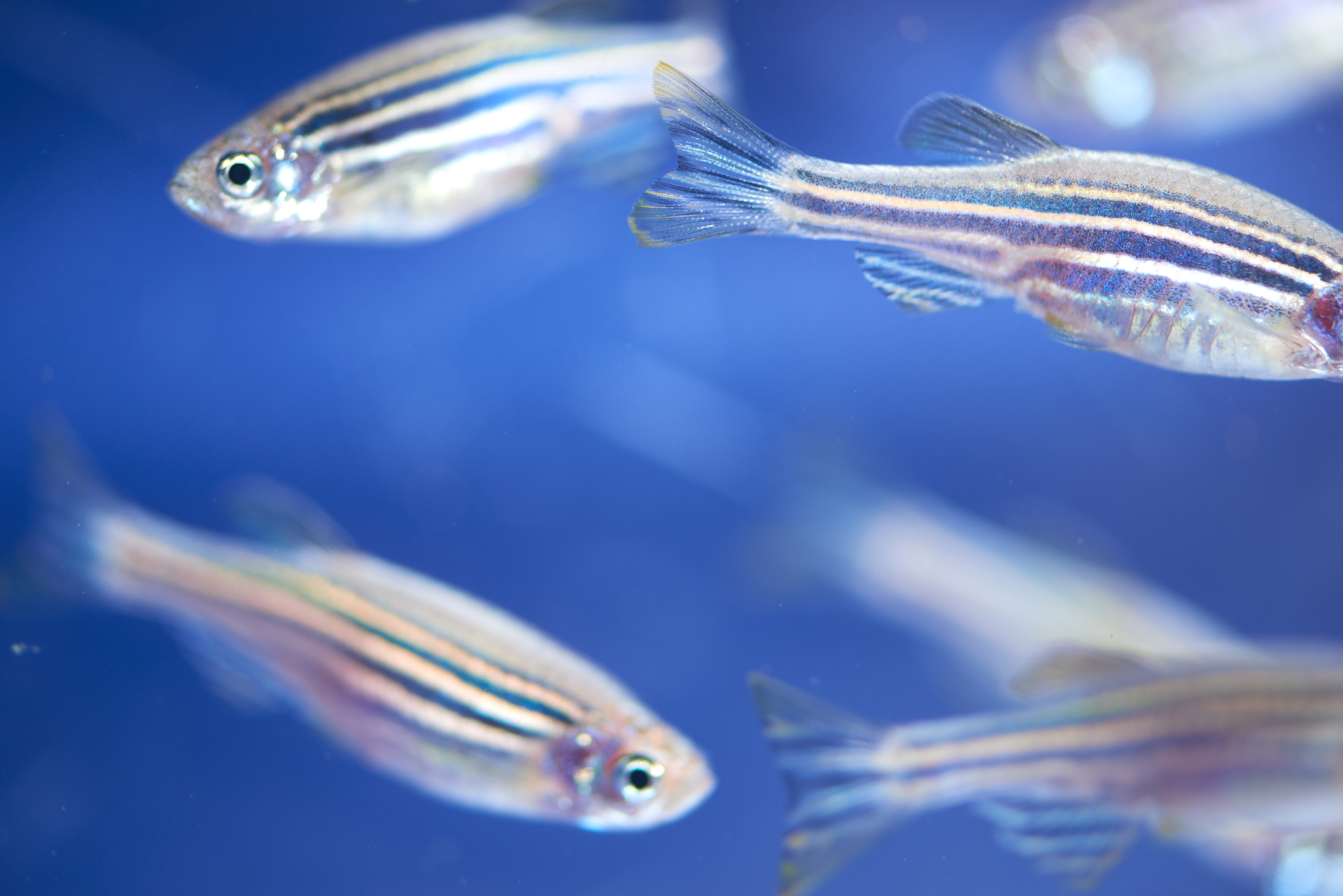Researcher profile: Camila Esguerra
Dr Camila Esguerra joined NCMM in 2014. Her research involves using zebrafish as a model to study brain function in health and disease. In this profile article, Camila discusses her research career so far, the benefits of using zebrafish in translational research, and her visions and plans for the future.


Tell us about your research background and aims
I am primarily a developmental geneticist by training but have acquired additional expertise in molecular biology, neurobiology and pharmacology over the course of my career.
After completing my Master’s degree at the Max Planck Institute for Developmental Biology in Germany, I spent several years working in the German biotech industry. I then returned to academia and obtained my PhD in Medical Sciences from the University of Leuven, Belgium, studying a signaling pathway important for establishing the left and right sides of the zebrafish embryo. I continued in Leuven as a postdoctoral fellow and eventually as a senior researcher where I developed the zebrafish as a model for preclinical drug discovery – both as a model for drug-induced organ toxicity and for modelling diseases such as congenital disorders, inflammation and epilepsy.
Currently, my group in Oslo is focused on understanding the mechanisms underlying neurological disorders such as epilepsy, schizophrenia and autism. Much of this work involves using zebrafish as a model organism.
When did researchers start using zebrafish in biomedical research, and what are the benefits to using zebrafish as an in vivo model for studying brain function (i.e. compared to other options such as fruit flies or mice)?
Zebrafish have been used since the 1950s as a sentinel for environmental toxicants. It wasn't until the 1970s, however, that the late George Streisinger, a professor at the University of Oregon, USA, created the first zebrafish clones and put zebrafish “on the map” as a potential genetic model organism.
It took another 20 years until zebrafish were first used in a large-scale mutagenesis screen, identifying hundreds of genes involved in early embryonic development and disease. This work was performed by Christiane Nüsslein Volhard, Director at Max Planck Institute for Developmental Biology, who won the Nobel Prize in 1995 for her work on the genetics governing the fruit fly body plan.
In terms of advantages, zebrafish embryos and larvae are small, which makes them a practical tool for biomedical research. For example, they are amenable to both large-scale drug and phenotype-based screening using an automated microtiter plate format. They are also vertebrates and therefore closer in physiology to humans than fruit flies.
The greatest advantage of the zebrafish however, is its optical transparency during the first weeks of development.
This feature allows researchers to perform non-invasive imaging of internal organs in live animals in real time - including brain activity monitoring, even in freely moving larvae. This means it is now possible to monitor neural activity patterns while the fish are displaying specific behaviours (for example, during prey capture). We have taken advantage of this unique feature by studying changes in the neuronal system that occur during development and within the context of disease progression.
How physiologically relevant are studies using zebrafish to human biology?
The overall homology between the zebrafish and human genomes is about 70%, but if one compares disease candidate genes, the degree of overlap is even higher. For example, zebrafish homologs have been identified for 88% of all human schizophrenia risk genes. With regard to human physiology, zebrafish have all of the same organs as humans with the exception of lungs and a uterus.
Based on some of the studies that I have been involved in, there were instances where zebrafish recapitulated human disease symptoms much more closely than the equivalent mouse model. In a similar fashion, our zebrafish models also responded to drugs in the same manner that human patients do, whereas the equivalent rodent models did not.
Are there any major discoveries that come to mind where zebrafish have been used as a major analytical tool?
Plenty! Zebrafish have been used to model many human diseases such as various cancers (e.g. leukemia, hepatocellular carcinoma, melanoma), muscular dystrophy, deafness, epilepsy, Parkinson's disease and even type 1 diabetes.
Zebrafish are also an excellent model system for studying rare genetic disorders.
Generally speaking, I believe that one of the greatest contributions that the zebrafish model has provided to the research community, is its high genetic tractability as an animal model for human diseases combined with its amenability to performing large-scale drug screens. Now that human geneticists are identifying variants for diseases and the technology for generating disease models in zebrafish is well optimized, I believe that zebrafish will also become a favoured model for precision medicine in the coming years.
One fascinating discovery that comes to mind relates to a study published very recently in the journal Nature (Leung LC et al., 2019). Researchers at Stanford University used calcium imaging to capture the neural activity patterns of sleeping two-week-old zebrafish while simultaneously monitoring heart rate, muscle activity, and eye movement. They discovered that zebrafish, like humans, enter in and out of rapid eye movement sleep. They even created sleepy fish by disrupting their "fish nap" periods and saw that the neural activity patterns changed as a result of sleep deprivation. The zebrafish sleep patterns were remarkably similar to that of humans - thus opening up possibilities for using zebrafish as a model for understanding the neural circuitry and evolutionary mechanisms governing sleep.
What project(s) are you working on at the moment, and what do you hope to discover?
Right now we are very focused on analyzing genetic models for CNS disorders (epilepsy, schizophrenia and autism), in order to understand the mechanisms that lead to a diseased brain. By pinpointing the earliest defects during brain development, we hope to identify new therapeutic entry points and eventually, drug leads for the treatment of these disorders.
What would you hope to achieve with another 4-year period at NCMM?
I would like to get to "the meat of the matter" and unravel new disease pathogenesis mechanisms. We now have a series of mutants that we have been characterizing and several of them recapitulate the human disease phenotype very well. We are also in discussions with our human genetics collaborators to generate mutant lines carrying specific human mutations as a "proof of principle" approach for future precision medicine studies.
Where do you think your field of research will be in ten years?
I believe that the zebrafish will become an increasingly favoured model for elucidating disease pathogenesis mechanisms and for precision medicine.
I also believe that a greater number of drug leads discovered using zebrafish-based screens will be entered into clinical trials.
Tell us a little bit about what you were doing before you joined NCMM
I was an industrial research fellow at the University of Leuven, Belgium. It was during this period that I established a research program to develop and validate the use of zebrafish as a model for epilepsy and drug toxicity testing.
Due to the nature of the research, I also ended up collaborating heavily with various partners in industry. This was a true eye-opener for me, as pharmaceutical companies have very different concerns with regard to preclinical drug discovery than basic researchers do. This has definitely shaped my approach to my own research, as I also take into consideration these types of research questions for projects that have a strong translational objective.
What has been the greatest moment in your career so far?
Being part of the very small number of laboratories worldwide who have placed zebrafish on the map as a valid and valuable model for epilepsy research and drug discovery.
What would you be doing if you weren’t working in research?
For as long as I can remember, I have always been interested in medicine and scientific research. I was already performing experiments at home, even as a child, so in all honesty, this is quite a tough question to answer. It is perhaps a bit too late to become a clinician. If I were “forced” to choose, it would definitely still involve medicine and/or science but I would perhaps tap more into my creative and imaginative side. Some of my “daydreams” involve envisioning how new technologies might affect us as human beings in the future. I was also told by several of my university professors that I am an excellent writer and was strongly encouraged to hone this skill. So, I suppose I could imagine myself as a science writer and science fiction novelist!
This being said, I would of course much prefer to keep my current day job, especially now that our research is getting very interesting!